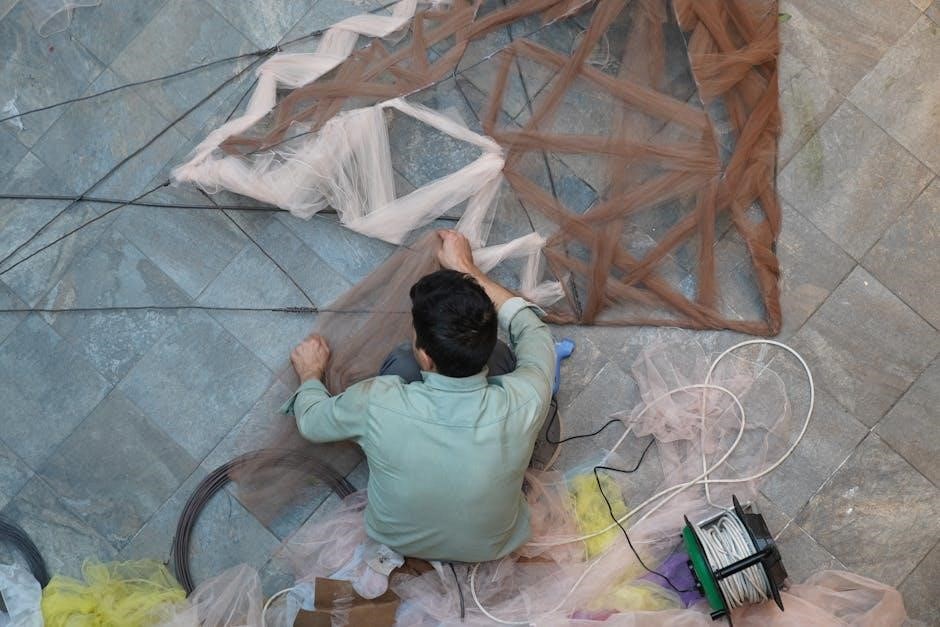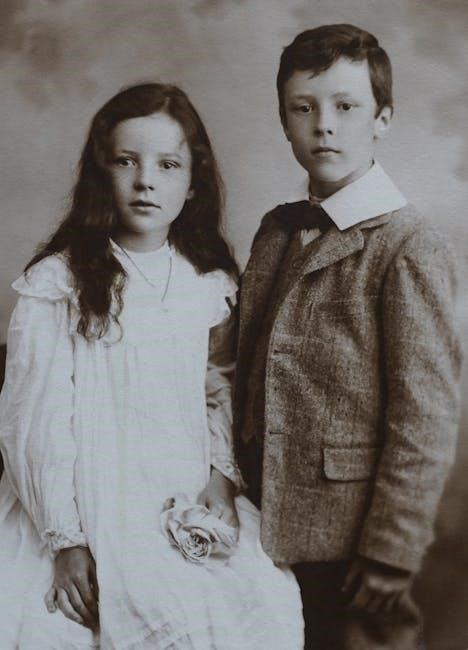
The Brother XL 2600i manual provides essential guidance for operating, maintaining, and troubleshooting this versatile sewing machine. It covers setup, stitch selection, threading, and maintenance, ensuring optimal performance and creativity for sewers of all skill levels. The manual is available in digital formats, including PDF, and is designed to help users maximize the machine’s potential while addressing common issues and promoting longevity.
Overview of the Brother XL 2600i Sewing Machine
The Brother XL 2600i is a versatile mechanical sewing machine designed for a wide range of sewing projects. It features a built-in needle threader, 25 built-in stitches, and a free-arm design for easy maneuverability. The machine is known for its durability and user-friendly interface, making it suitable for both beginners and experienced sewers. With its compact design and optional accessories, the Brother XL 2600i is ideal for quilting, garment construction, and home decor projects. The machine also comes with a comprehensive manual, ensuring seamless operation and troubleshooting.
Importance of Reading the Manual
Reading the Brother XL 2600i manual is essential for understanding its features, operation, and maintenance. It provides step-by-step guidance for setting up the machine, selecting stitches, and troubleshooting common issues. The manual ensures safe usage, optimal performance, and helps you make the most of its capabilities. By following the instructions, you can avoid errors, extend the machine’s lifespan, and achieve professional-quality results in your sewing projects.

Key Features of the Brother XL 2600i Sewing Machine
The Brother XL 2600i offers versatile stitch options, user-friendly controls, and durable construction, making it ideal for both beginners and experienced sewists. It ensures precision and creativity in various sewing projects.
Stitch Selection and Customization
The Brother XL 2600i offers a variety of built-in stitches, including straight, zigzag, and decorative options, catering to different fabric types and sewing needs. Users can easily select stitches using a dial or button controls, allowing for quick adjustments. The machine also features customizable stitch length and width settings, enabling precise control over sewing results. This versatility makes it suitable for both basic repairs and intricate creative projects, ensuring high-quality outcomes for every task.
Presser Foot Mechanism
The Brother XL 2600i features a versatile presser foot mechanism designed to handle various fabrics and sewing tasks effortlessly. It includes multiple presser feet, such as the zigzag foot and specialized options for heavy-duty materials. The mechanism allows for smooth fabric feeding, ensuring even stitches and preventing fabric slippage. Easy to install and adjust, the presser foot enhances control over fabric movement, making it ideal for both delicate and thick fabrics. This feature is crucial for maintaining consistent stitching quality and versatility in different sewing projects.
Bobbin and Threading System
The Brother XL 2600i features a seamless bobbin and threading system designed for efficiency. The automatic needle threader simplifies threading, while the quick-set bobbin ensures easy installation. The machine includes a magnetic bobbin pin for secure placement, reducing thread tangling. The bobbin case is designed for smooth thread flow, maintaining consistent tension. This system minimizes eye strain and frustration, allowing for focus on creative sewing. Its intuitive design ensures proper thread placement and alignment, enabling smooth stitching and versatile project execution.
Setting Up Your Brother XL 2600i Sewing Machine
Setting up your Brother XL 2600i involves unpacking, placing it on a stable surface, connecting the power cord, and performing initial checks. Ensure it’s plugged into a grounded outlet for safe operation.
Unpacking and Initial Inspection
When unpacking your Brother XL 2600i, carefully remove the machine and accessories from the box. Inspect for any visible damage or missing parts. Ensure all included accessories, such as presser feet, needles, and the power cord, are present. Gently wipe the machine with a soft cloth to remove any packaging residue. Verify that the stitch selector, bobbin area, and presser foot mechanisms are clean and free from debris. This step ensures a smooth setup and operation experience.
Placing the Machine on a Stable Surface
Position the Brother XL 2600i on a flat, stable surface, such as a sewing table or countertop. Ensure the area is clear of clutter and away from direct sunlight to prevent overheating. Choose a location with good lighting to enhance visibility while sewing. Avoid placing the machine on soft or uneven surfaces, as this may cause instability. Ideally, place it on a hard, non-slip surface to maintain balance and prevent accidental movement during operation.
Connecting the Power Cord
Insert the power cord into the designated socket on the machine. Ensure the cord is fully seated to maintain a secure connection. Plug the other end into a grounded electrical outlet rated for 120V AC. Avoid using extension cords or overloaded outlets to prevent power issues. Once connected, verify the machine’s power switch is in the “off” position before turning it on. The machine’s LED light will indicate when it is powered on and ready for use.

Threading the Brother XL 2600i Sewing Machine
Proper threading is essential for smooth operation. Follow the manual’s guide to thread the top and bobbin correctly. Use the correct thread type for your fabric to ensure optimal stitching quality and prevent issues.
Threading the Top Thread
To thread the top thread on the Brother XL 2600i, start by placing the spool on the spool pin. Gently pull the thread through the guide located above the machine. Pass it through the tension dial, ensuring it clicks into place. Next, loop the thread around the take-up lever and guide it downward toward the needle. Insert the thread through the needle’s eye from front to back. Pull the thread gently to ensure it is seated properly. Avoid pulling too tight, as this may cause misalignment;
Threading the Bobbin
Access the bobbin compartment by opening the small door or releasing the latch. Remove the empty bobbin and replace it with the new one. Wind the thread evenly around the bobbin, ensuring it’s neither too tight nor too loose. Insert the wound bobbin back into the compartment, aligning it properly. Guide the thread through the tension disk and pull gently to secure it. Close the compartment and test by sewing a few stitches to ensure smooth thread feeding. Proper seating is crucial for even stitches and to prevent thread breakage.
Ensuring Proper Thread Tension
Proper thread tension is vital for consistent stitching. Check the top thread tension by gently pulling it; it should feel firm but not overly tight. For the bobbin thread, lift the machine’s presser foot and pull the bobbin thread. It should have a slight resistance. If either thread is too loose or too tight, adjust the tension dials according to the manual. Test the tension by sewing on scrap fabric and adjusting as needed to achieve even, balanced stitches. Proper tension prevents puckering or loose stitching.

Using the Stitch Selector
The stitch selector simplifies choosing the right stitch for various fabrics. It allows quick access to different stitch types and customization of stitch length and width.
Understanding Stitch Types
The Brother XL 2600i offers a variety of stitch types, including straight, zigzag, reverse, and stretch stitches. These stitches cater to different fabrics and sewing tasks, ensuring versatility. Understanding each stitch’s purpose helps in achieving professional results. Straight stitches are ideal for general sewing, while zigzag is perfect for preventing fraying. Decorative stitches add aesthetic value, and stretch stitches are suitable for elastic fabrics. Familiarizing yourself with these options enhances your sewing experience and project outcomes.
Adjusting Stitch Length and Width
The Brother XL 2600i allows precise adjustment of stitch length and width to suit various fabrics and sewing needs. Use the stitch dial or button to modify settings. The stitch length determines how much fabric is sewn between stitches, while the width affects the zigzag or decorative stitch size. Adjusting these ensures proper fabric handling and desired seam strength. Refer to the LCD display for current settings. Fine-tuning these parameters enhances stitch quality and ensures professional-looking results for every project.
Selecting the Right Stitch for Your Fabric
Selecting the appropriate stitch for your fabric ensures optimal results. The Brother XL 2600i offers various stitches, from basic straight and zigzag to decorative options. For heavier fabrics like denim, use a straight or reinforced straight stitch. Delicate fabrics benefit from a shorter, finer zigzag stitch. Test stitches on scrap fabric to ensure compatibility. Choosing the right stitch enhances seam strength and prevents fabric damage, ensuring professional-looking results for any sewing project.

Bobbin Management
Proper bobbin management ensures smooth stitching and consistent tension. Always use the correct bobbin size and type, winding it neatly to prevent tangles or bunching for optimal performance.
Winding the Bobbin
Winding the bobbin correctly is essential for smooth stitching. Place the thread on the bobbin pin and gently pull it to align. Hold the thread tail, turn the handwheel toward you to wind. Ensure the thread fills the bobbin evenly, avoiding overfilling. Stop when the bobbin is about 80% full. Cut the thread tail and remove the bobbin from the pin. Properly wound bobbins prevent tangling and maintain consistent stitch quality during sewing.
Installing the Bobbin
Installing the bobbin correctly ensures proper stitching. Pull the thread tail through the bobbin slot, then insert the bobbin into the bobbin case. Gently pull the thread to seat the bobbin. Close the bobbin case securely. Ensure the bobbin is seated properly and the thread is not tangled or too tight. This step is crucial for maintaining consistent stitch quality and preventing sewing interruptions. Always refer to the manual for specific alignment and seating guidance to avoid misalignment issues during installation.
Troubleshooting Bobbin Issues
If the bobbin causes stitching problems, check for improper seating or tangled thread. Remove the bobbin and gently untangle the thread. Ensure the bobbin is correctly aligned with the machine’s bobbin case. If the bobbin doesn’t move, verify the presser foot is raised and the machine is properly threaded. Consult the manual for guidance on resetting or replacing the bobbin. Regularly cleaning the bobbin area can prevent such issues. Always maintain the correct thread tension to avoid further complications during sewing.

Presser Foot Operations
Presser foot operations involve raising and lowering mechanisms, using different feet for fabrics, and ensuring synchronization with the needle for precise stitching.
Raising and Lowering the Presser Foot
Raising and lowering the presser foot is essential for fabric management. Use the presser foot lever, located on the back or side, to lift or lower it. Always lower it before sewing to ensure fabric stays in place. For thick fabrics, the foot can be adjusted manually. Make sure the foot is fully down for proper stitching. If it’s not lowered, the machine may not stitch correctly. Always check the foot’s position before starting your project.
Using Different Presser Feet for Various Fabrics
The Brother XL 2600i supports various presser feet for different fabrics. Use the all-purpose foot for cotton and polyester. For heavy fabrics, switch to the walking foot. The zipper foot is ideal for zippers and piping, while the Teflon foot works best with silk or nylon. Always choose the right foot for your fabric type to ensure smooth stitching and prevent fabric slippage. Changing presser feet is easy—simply snap off the old one and attach the new one. This versatility enhances your sewing experience.

Troubleshooting Common Issues
This section helps identify and resolve common issues with the Brother XL 2600i, ensuring smooth operation and optimal performance for all projects.
Thread Breakage
Thread breakage can occur due to improper threading, incorrect tension, or using low-quality thread. To fix this, re-thread the machine following the manual’s guide, ensuring the presser foot is up. Adjust the tension dials to the recommended settings for your fabric type. Use high-quality, compatible thread to minimize breakage. If issues persist, check for debris in the tension discs or take the machine to an authorized service center. Regular maintenance can help prevent such problems.
Machine Not Stitching Properly
If the machine is not stitching properly, check the stitch settings and ensure the correct stitch type is selected for your fabric. Verify that the presser foot is lowered and the fabric is placed correctly. Inspect the thread tension; if it’s too tight or loose, adjust it accordingly. Ensure the bobbin is properly installed and the thread is not tangled. If the issue persists, clean the machine’s interior and lubricate moving parts. Consult the manual or contact support for further assistance to resolve stitching issues effectively.
Feed Dogs Not Moving
If the feed dogs are not moving, first ensure they are properly engaged. Check the feed dog setting and switch if necessary. Clean the feed dog area to remove lint or debris that may block their movement. If the issue persists, inspect for mechanical obstructions or damage. Refer to the manual for troubleshooting steps or contact Brother support for assistance. Proper feed dog function is essential for smooth fabric movement during sewing.

Maintenance Tips
Regularly clean the machine to remove lint and dust, ensuring smooth operation. Oil internal parts as recommended to prevent friction. Check and replace needles frequently for optimal performance. Refer to the manual for detailed servicing schedules to maintain your Brother XL 2600i in top condition.
Cleaning the Machine
Regular cleaning of the Brother XL 2600i sewing machine is essential for maintaining its performance and longevity. Turn off and unplug the machine before cleaning; Use a soft, dry cloth to wipe down the exterior and remove any dust or debris. For the interior, gently brush away lint and thread remnants near the bobbin area and feed dogs using a small, soft-bristled brush. Avoid using liquids or harsh chemicals, as they may damage the machine’s components. Cleaning regularly ensures smooth operation and prevents thread breakage.
Oiling the Machine
Regular oiling is essential to maintain the Brother XL 2600i’s smooth operation. Locate the oiling points as indicated in the manual. Turn off the machine and apply a few drops of sewing machine oil to the designated areas. Allow the oil to settle before use. Excess oil can be wiped with a soft cloth. Proper lubrication prevents friction and ensures consistent stitching. Oil your machine after heavy use or every 6 months to keep it in optimal condition.
Regular Servicing
Regular servicing is essential to maintain the Brother XL 2600i’s performance and longevity. It is recommended to have your machine professionally serviced every 12 to 18 months, depending on usage. During servicing, a technician will clean internal components, lubricate moving parts, and inspect belts and gears for wear; Additionally, check and replace the needle bar, hook race, and bearings if necessary. Proper servicing ensures smooth operation, prevents mechanical issues, and extends the machine’s lifespan. Always use genuine Brother parts for replacements.

Accessories and Optional Parts
The Brother XL 2600i offers various accessories, including multiple presser feet for specialized tasks, additional needles, and extra bobbins. These enhance sewing versatility and efficiency.
Available Presser Feet
The Brother XL 2600i sewing machine offers a variety of presser feet to enhance sewing versatility. The standard Zigzag Foot (included) is ideal for general sewing. Optional feet include the Zipper Foot for zippers and piping, the Buttonhole Foot for precise buttonholes, and the Blind Stitch Foot for invisible hems. Additional feet, like the Walking Foot, are available for heavy or layered fabrics. These accessories can be purchased from Brother’s official website or authorized dealers to expand your sewing capabilities.
Additional Needles and Bobbins
The Brother XL 2600i supports a variety of needles and bobbins to enhance your sewing experience. Standard sewing machine needles (Size 11-14) are recommended for general use, while specialized needles like denim or embroidery needles are ideal for specific fabrics. Genuine Brother bobbins are designed to ensure smooth operation and consistent stitching. Always use compatible accessories to maintain performance and longevity. For additional needles and bobbins, visit authorized Brother retailers or official online stores to ensure authenticity and quality.

Downloading and Printing the Manual
To download the Brother XL 2600i manual, visit Brother’s official website and navigate to the support section. Search for “XL2600i” to find the PDF manual.
- Official Sources: Ensure you download from Brother’s official website for authenticity and safety.
- Printing Tips: Use high-quality paper and color printing for clear diagrams. Adjust printer settings for optimal page formatting.
Printing the manual allows easy reference while using the machine, ensuring all features and troubleshooting guides are readily accessible.
Official Sources for the Manual
The official manual for the Brother XL 2600i sewing machine can be found on Brother Industries’ official website. Visit the Brother support page and search for the XL 2600i model to access the downloadable PDF version. Additionally, authorized Brother retailers and the Brother Customer Support Center provide direct links to the manual. Ensure you only download from trusted sources to avoid unauthorized versions. For physical copies, check the packaging or contact Brother directly for assistance.
Printing Tips
When printing the Brother XL 2600i manual, ensure your printer is set to the correct paper size and orientation. Use high-quality paper for clarity, especially for diagrams and charts. Print in color if possible to maintain the original formatting. Consider using a binder or three-ring binder to keep the manual organized. For large sections, adjust print settings to avoid excessive ink usage. Always verify the manual version matches your machine before printing. Refer to Brother’s official website for the most updated PDF version.
The Brother XL 2600i sewing machine manual is an essential guide for mastering your sewing experience. It provides detailed instructions to unlock the machine’s potential, from basic setup to advanced stitching techniques. By following the manual, you can troubleshoot common issues, maintain the machine, and explore its versatile features. Whether you’re a beginner or an experienced sewer, this manual ensures you make the most of your Brother XL 2600i. Happy sewing!
Always refer back to the manual for tips and guidance to keep your machine functioning optimally.